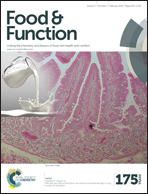Inclusion of ancient Latin-American crops in bread formulation improves intestinal iron absorption and modulates inflammatory markers
Abstract
This study compares iron (Fe) absorption in Fe-deficient animals from bread formulations prepared by substitution of white wheat flour (WB) by whole wheat flour (WWB), amaranth flour (Amaranthus hypochondriacus, 25%) (AB) and quinoa flour (Chenopodium quinoa, 25%) (QB), or chia flour (Salvia hispanica L, 5%) (ChB). Hematological parameters of Fe homeostasis, plasmatic active hepcidin peptide production (LC coupled to Ms/Ms), and liver TfR-2 and IL-6 expression (RT-qPCR) were determined. The different bread formulations increased Fe content between 14% and 83% relative to white bread. Only animals fed with WWB, AB and ChB increased haemoglobin concentrations significantly. Feeding the different bread formulations did not increase hepcidin levels, but down-regulated transferrin receptor 2 (TfR2) (apart from WWB) and IL-6 (apart from QB) expression levels. Only AB and ChB had a significant influence on Fe bioavailability at the investigated level of substitution. The potential contribution of these flours would not differ considerably from that of WWB.


 Please wait while we load your content...
Please wait while we load your content...